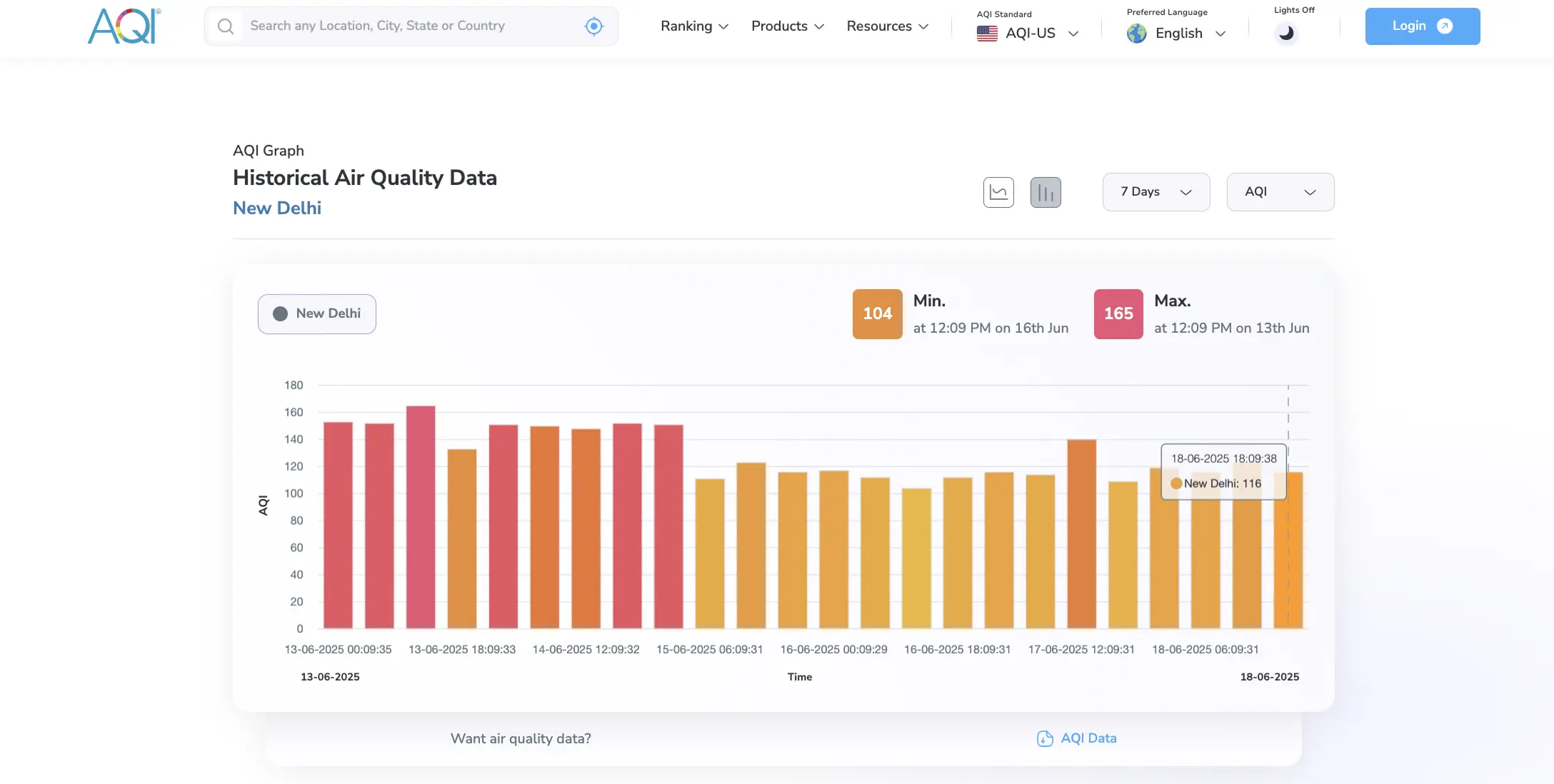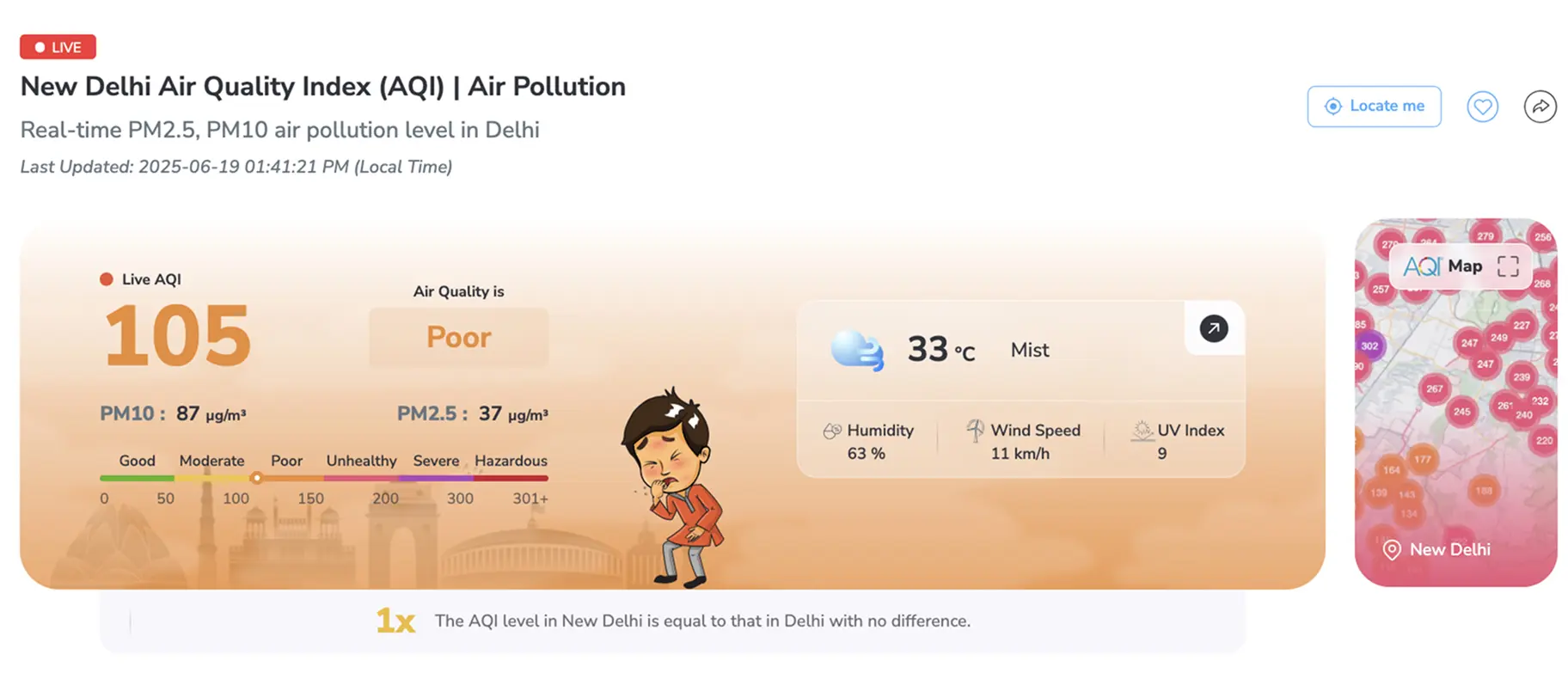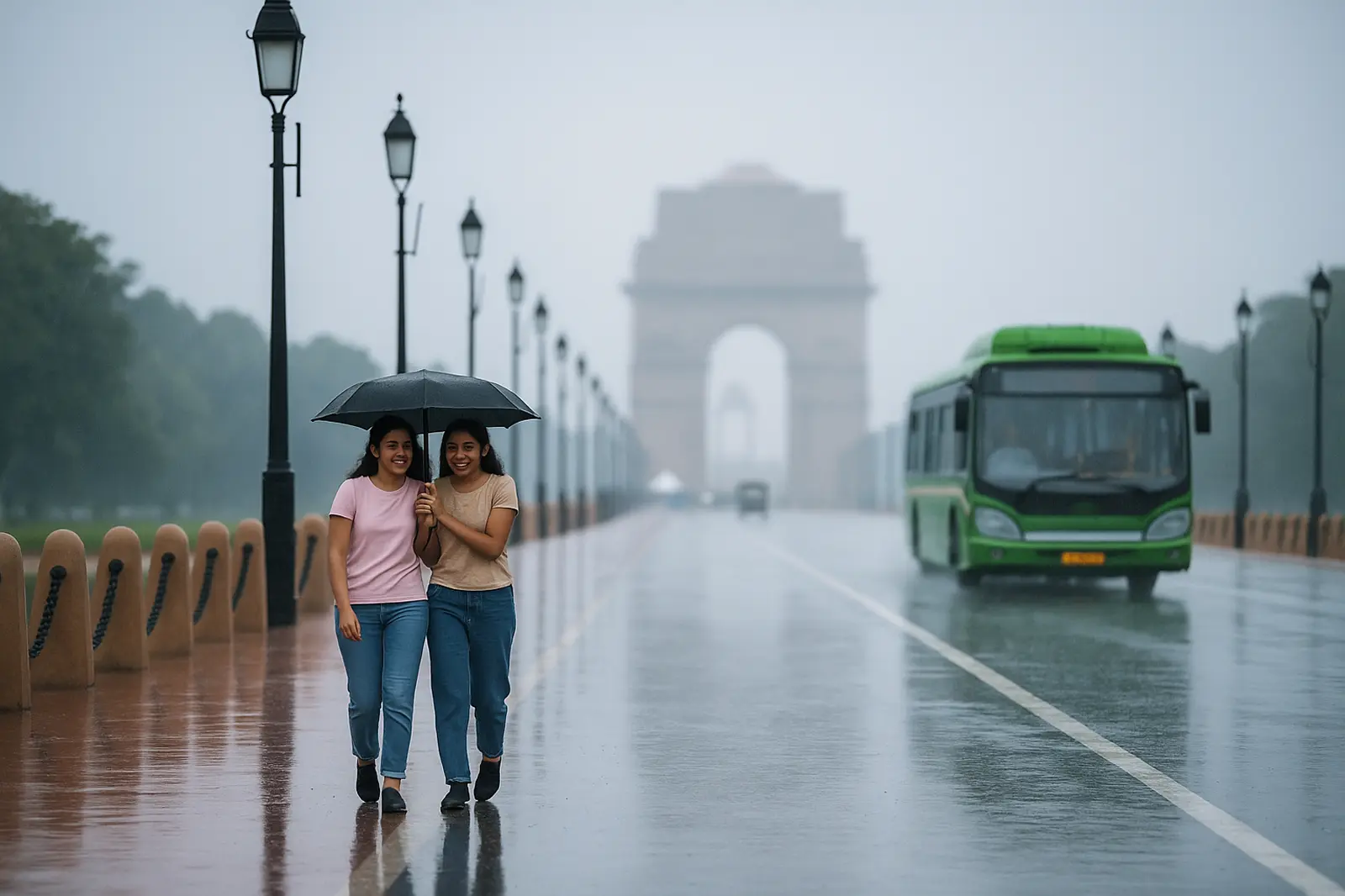After more than eight months of persistently unhealthy air, Delhi AQI drops after months. As Air finally caught a fleeting breath of cleaner air thanks to a strong rainstorm on June 18, 2025. The downpour, accompanied by gusty winds, temporarily pushed the city’s Air Quality Index (AQI) into the “Satisfactory” range in some areas — a status the capital had not achieved since mid-2024. Yet, by the next morning, pollution had already rebounded, serving as a stark reminder that natural weather events offer only short-term relief in a city where structural pollution sources continue unabated.
This article explores what caused the drop in air pollution, how the trend fits into the broader 2025 pattern, why air quality worsened again so quickly, and what this means for Delhi’s future.
Delhi AQI Drops After Months: What Happened on June 18?
At approximately 6:00 p.m. on June 18, Delhi experienced a heavy thunderstorm that delivered nearly 29 mm of rainfall across the city. The storm also brought wind speeds exceeding 40 km/h, which helped disperse pollutants trapped near the surface.

The results were immediate and dramatic. According to real-time AQI data from AQI.in:
- New Delhi’s AQI dropped in the evening.
- The PM2.5 levels, which usually range from 100–150 µg/m³ in the summer, fell to around 37 µg/m³.
- PM10 values dropped to 87 µg/m³, down from typical levels of 200+ µg/m³.
The brief period of clean air was widely felt and even visible: clearer skies, lower temperatures, and easier breathing were reported across the NCR.
The Rebound: June 19 Morning Sees AQI Climb Again
Unfortunately, the Delhi AQI drops after months, and the positive impact was short-lived. As the storm passed and wind speeds dropped, the pollutants returned quickly.

By 10:00 a.m. on June 19:
| Location | AQI | Category | PM2.5 (µg/m³) | PM10 (µg/m³) |
| Aerocity | 96 | Moderate | 33 | 68 |
| Anand Vihar | 90 | Moderate | 30 | 79 |
| Connaught Place | 98 | Moderate | 34 | 79 |
| Greater Kailash-1 | 111 | Poor | 40 | 72 |
| Darya Ganj | 95 | Moderate | 33 | 96 |
Even the best-performing localities had returned to “Moderate,” and the city-wide average had once again entered the “Poor” zone.
Delhi’s AQI Trend in 2025: A Data-Driven Overview
To understand the context of this brief improvement, it’s important to analyze the full air quality trend for 2025 so far. Despite isolated Delhi AQI drops after months, the overall picture remains troubling.
| Month | Avg. AQI | Category | Key Features |
| January | 218 | Severe | Dense winter smog, weak wind, crop burning remnants |
| February | 169 | Unhealthy | Cold air, low wind speed, vehicle and heating emissions |
| March | 143 | Poor | Mild improvement, but persistent pollution |
| April | 152 | Unhealthy | Ozone levels rose sharply as sunlight intensified |
| May | 138 | Poor | High temperatures triggered ground-level ozone formation |
| June (till 19th) | 134 | Poor | Intermittent rain, drop in dust and PM levels on rainy days |
The Science: Why Rain Improves AQI — But Temporarily
Rain improves air quality through a process called wet deposition. As rain falls, it captures airborne particles (like dust, soot, and smoke) and pulls them to the ground. This includes:

- PM2.5: Fine particles that penetrate deep into lungs.
- PM10: Coarse dust that irritates eyes, nose, and throat.
- Allergens and pollen, which also decrease post-rain.
Additionally, thunderstorms bring high wind speeds, which help disperse localized pollution hotspots and encourage vertical mixing of the air — pushing polluted surface air higher into the atmosphere.
But once the rain ends:
- Stagnant conditions return quickly.
- Pollution sources resume (vehicles, construction, burning).
- No structural emissions control is in place to prevent quick re-accumulation.
The Summer Threat: Ground-Level Ozone
While PM pollution dipped briefly, ozone remains a hidden danger. Unlike PM, ozone is not emitted directly. It forms when nitrogen oxides (NOx) and volatile organic compounds (VOCs) react under sunlight.
In April and May 2025:
- Many Delhi localities recorded ozone spikes above 120 µg/m³.
- Ozone is especially harmful during heatwaves, which have increased in frequency.
Ozone affects even healthy lungs and can trigger chest pain, coughing, shortness of breath, and increased hospital admissions for respiratory diseases.
Why Air Quality Keeps Getting Worse Again?
Delhi’s return to poor air quality after every short-lived weather relief stems from structural pollution sources that operate daily:
- Vehicles: Delhi has over 1.2 crore registered vehicles, many of them diesel-powered.
- Construction Activity: Road, metro, and private projects release massive dust.
- Industrial Emissions: NCR-based industries, brick kilns, and small factories add to local load.
- Open Burning: Illegal garbage and crop waste burning in outskirts worsens air.
- Urban Heat Island Effect: Delhi’s dense construction traps heat and pollution.
These are ongoing issues that are unaffected by a single storm or temporary policy.
Health Impact: What Delhi’s Air Means for You?
The health implications of PM and ozone pollution are severe:
- PM2.5 is associated with lung cancer, heart attacks, and developmental issues in children.
- Long-term exposure can reduce life expectancy by up to 9 years, according to a study by the Energy Policy Institute at the University of Chicago.
- Daily exposure to AQI >150 is equivalent to smoking 6 cigarettes/day, especially in vulnerable groups.
People with asthma, COPD, cardiovascular disease, or diabetes are at especially high risk during these conditions.
Forecast Ahead: More Rain, More Hope?
The India Meteorological Department (IMD) has issued a yellow alert for further rainfall this week. While this may temporarily bring AQI back down to “Moderate” levels again, weather alone cannot maintain breathable air.
Meteorologists warn that Delhi’s monsoon pattern is becoming increasingly erratic due to climate change. Short bursts of heavy rain followed by long dry periods create a boom-bust cycle for air quality.
Conclusion: Delhi AQI drops after months, Long-Term Problem
Delhi’s June 18 rain offered a glimpse of the air quality the city could enjoy — if emissions were controlled year-round. But the rapid rebound in pollution within 12 hours shows that nature cannot solve Delhi’s air crisis on its own.